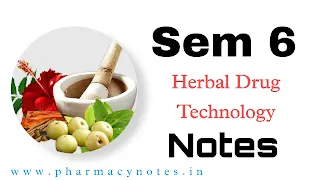Handwritten Notes
Semester 6
BP 603 T. HERBAL DRUG TECHNOLOGY (Theory)
Scope: This subject gives the student the knowledge of basic understanding of the herbal drug industry, the quality of raw material, guidelines for quality of herbal drugs, herbal cosmetics, natural sweeteners, nutraceuticals, etc. The subject also emphasizes Good Manufacturing Practices (GMP), patenting, and regulatory issues of herbal drugs
Objectives: Upon completion of this course the student should be able to:
1. understand raw material as the source of herbal drugs from cultivation to herbal drug product
2. know the WHO and ICH guidelines for evaluation of herbal drugs
3. know the herbal cosmetics, natural sweeteners, nutraceuticals
4. appreciate patenting of herbal drugs, GMP.
2. know the WHO and ICH guidelines for evaluation of herbal drugs
3. know the herbal cosmetics, natural sweeteners, nutraceuticals
4. appreciate patenting of herbal drugs, GMP.
Course content:
UNIT-I
Herbs as raw materials
Definition of herb, herbal medicine, herbal medicinal product, herbal drug preparation
Source of Herbs
Selection, identification, and authentication of herbal materials
Processing of herbal raw material
Biodynamic Agriculture
Good agricultural practices in the cultivation of medicinal plants including Organic farming.
Pest and Pest Management in medicinal plants: Biopesticides/Bioinsecticides.
Indian Systems of Medicine
a) Basic principles involved in Ayurveda, Siddha, Unani, and Homeopathy
b) Preparation and standardization of Ayurvedic formulations viz Aristas and Asawas, Ghutika, Churna, Lehya, and Bhasma.
UNIT-II
Nutraceuticals
General aspects, Market, growth, scope, and types of products available in the market. Health benefits and role of Nutraceuticals in ailments like Diabetes, CVS diseases, Cancer, Irritable bowel syndrome, and various Gastrointestinal diseases. Study of the following herbs as health food: Alfalfa, Chicory, Ginger, Fenugreek, Garlic, Honey, Amla, Ginseng, Ashwagandha, Spirulina
Herbal-Drug and Herb-Food Interactions: General introduction to interaction and classification. Study of the following drugs and their possible side effects and interactions: Hypercium, kava-kava, Ginkobiloba, Ginseng, Garlic, Pepper & Ephedra.
UNIT-III
Herbal Cosmetics
Sources and description of raw materials of herbal origin used via, fixed oils, waxes, gums colors, perfumes, protective agents, bleaching agents, and antioxidants in products such as skincare, haircare, and oral hygiene products.
Herbal excipients:
Herbal Excipients – Significance of substances of natural origin as excipients – colorants, sweeteners, binders, diluents, viscosity builders, disintegrants, flavors & perfumes.
Herbal formulations :
Conventional herbal formulations like syrups, mixtures, and tablets and Novel dosage forms like pyrosomes
UNIT- IV
Evaluation of Drugs WHO & ICH guidelines for the assessment of herbal drugs
Stability testing of herbal drugs.
Patenting and Regulatory requirements of natural products:
a) Definition of the terms: Patent, IPR, Farmers right, Breeder’s right, Bioprospecting and Biopiracy
b) Patenting aspects of Traditional Knowledge and Natural Products. Case study of Curcuma & Neem.
Regulatory Issues - Regulations in India (ASU DTAB, ASU DCC), Regulation of manufacture of ASU drugs - Schedule Z of Drugs & Cosmetics Act for ASU drugs.
Available soon
UNIT-V
General Introduction to Herbal Industry
Herbal drugs industry: Present scope and future prospects.
A brief account of plant-based industries and institutions involved in work on medicinal and aromatic plants in India.
Schedule T – Good Manufacturing Practice of Indian systems of medicine
Components of GMP (Schedule – T) and its objectives
Infrastructural requirements, working space, storage area, machinery, and equipment,
standard operating procedures, health and hygiene, documentation, and records.
Available soon








Please do not enter any spam link in the comment box.